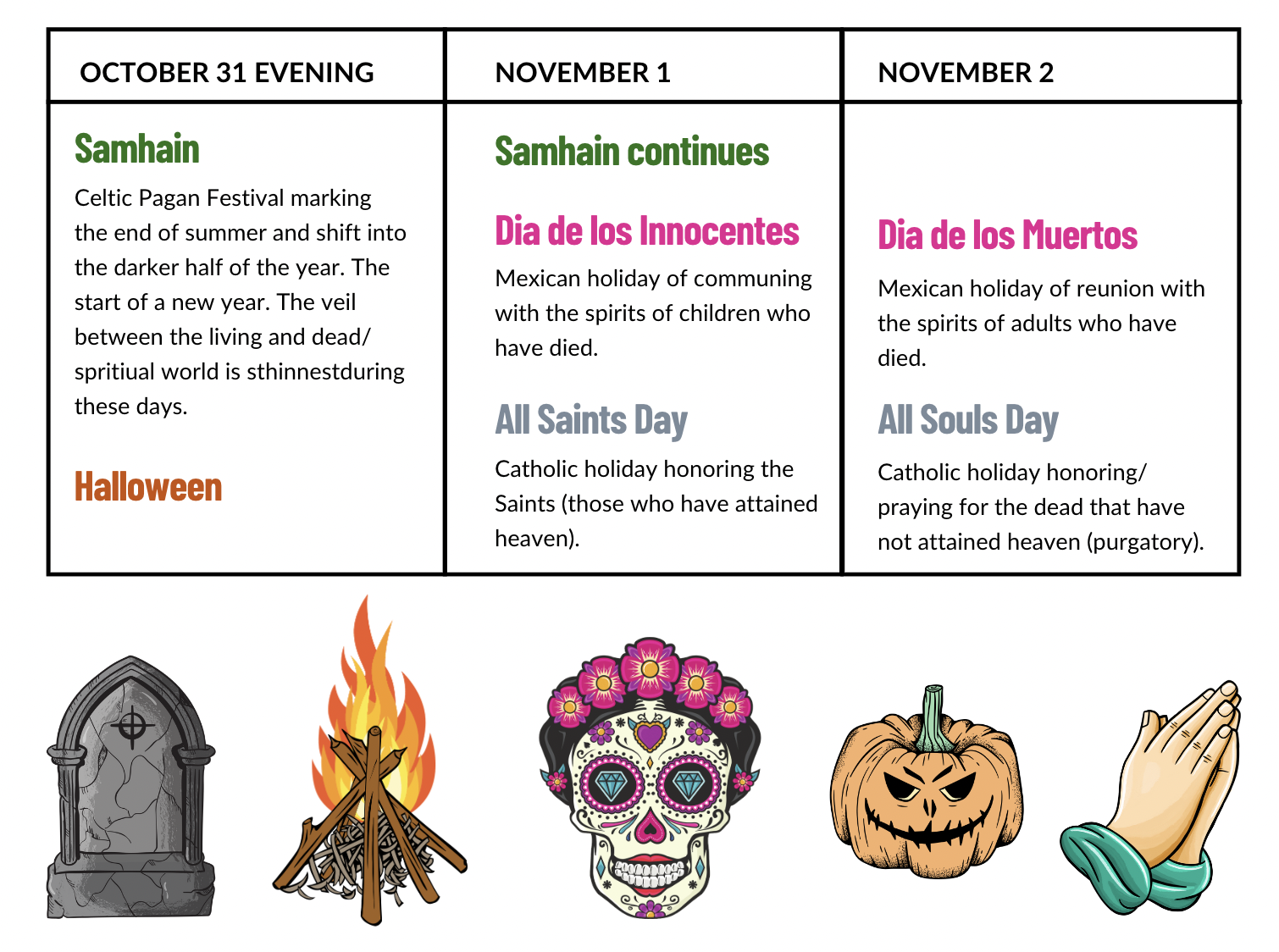ALL the Days of the Dead + The Evolution of Halloween
Happy Samhain, Halloween, Dia de los Innocentes, Dia de los Muertos, All Saints Day, and All Souls Day.
Yes, all of them – they are all in this three day stretch from October 31 - November 2.
Notice a pattern here?
All of these holidays are about the dead, connecting with and honoring spirits. The original festival was Samhain (pronounced Sah-win), which has been celebrated by Pagans for at least 4000 years. Then, the Catholic Church decided to capitalize on the popularity of the festival and repurpose it as a Catholic Holiday (All Saints Day was established in 609AD and All Souls Day in 1000AD).
In Mexico: Reconnecting with loved ones
For 3000 years, there have been rituals and festivals around reuniting and connecting with the dead in what is now Mexico. Indigenous civilizations celebrated festivals to reconnect with deceased spirits, believing that for one night, those spirits can return to connect with loved ones. These festivals are now Dias de los Inocentes and Muertos.
The only reason the timing now aligns is that when European settlers came to Mexico, it apparently made sense for the traditional rituals to occur at the same time All Saints and Souls Days did with the Catholic Church’s calendar. So it’s clearly no coincidence that these celebrations overlap.
Samhain: When spirits walk among the living
Samhain is one of the major festivals of the Celtic Wheel of the Year. In fact, it marks the beginning of the Pagan year. It is believed that during this time, the veil between the earthly plane and spiritual plane is thin because it is the time when we are moving from the light into the darkness. Accordingly, ancient Pagans believed that during these days (technically it was a three-day festival then), spirits of the dead could come through the veil and walk among the living.
Halloween: Warding off ghosts
During Samhain, Pagans specifically believed that malevolent spirits could wreak havoc. So bonfires would burn all day and night, and people would disguise themselves as demons or spirits in order to deter any malevolent spirits from harming the living. This is where the modern Halloween’s tradition of dressing up originally comes from.
Also of note: the Samhain traditions of “souling” and “guising.” Souling: the poor would knock door to door and pray for the souls of each home’s departed loved ones. In exchange, they would receive sweet cakes called “soul cakes,” made specifically for the festival days. Guising: young children would also go door to door to perform music, poetry, jokes, etc. in exchange for money, wine or food. This is where it is believed our tradition of Trick or Treating originally comes from.
Despite the traditions being connected to the Oct. 31st Samhain rituals, the origins of the name “Halloween” are actually from the Catholic takeover of Samhain on Nov. 1 becoming “All Saint’s Day.”
Another word for Saint is Hallow (holy person).
Originally All Saint’s Day was called “Allhallowsmas”
And eventually “All Hallows Day”
So the day before became “All Hallows Eve”
And eventually “Halloween”
The first white settlers of America, being Puritan, were against such holidays. But in the mid-19th Century, escaping famine, thousands of Irish immigrated to the US and brought Samhain practices with them. Traditions evolved, including the costumes and trick-or-treating, as well as bonfires to keep away malevolent spirits eventually becoming jack-o-lanterns.
Does knowing this change anything for you?
I’d love to hear if this changes your sentiments about Halloween or any of the other holidays celebrated at this time. For me, I always feel most connected to rituals and holidays that were celebrated long before modern religious practices. So I am looking at this all a bit differently now, and perhaps you might as well.
In addition to whatever celebrations you have planned for any of these holidays, also consider:
Honoring the end of harvest and moving into the darkest half of the year.
Or take a moment to think about and connect with your loved ones on the other side of the veil.
You could even make an altar to them and leave sweet treats as is custom in Mexico during this time.
And during these challenging times, perhaps give in some way to the unhoused on this day, as was practice with the Souling of times gone by.
Whether or not these days sit differently for you, I hope that you will remember the origins of the traditions we now have, and connect with the spirituality of these days in addition to the more secular fun.
Happy All the Days of the Dead!
Rev. Dev
The Connected Way™
www.theconnectedway.com

